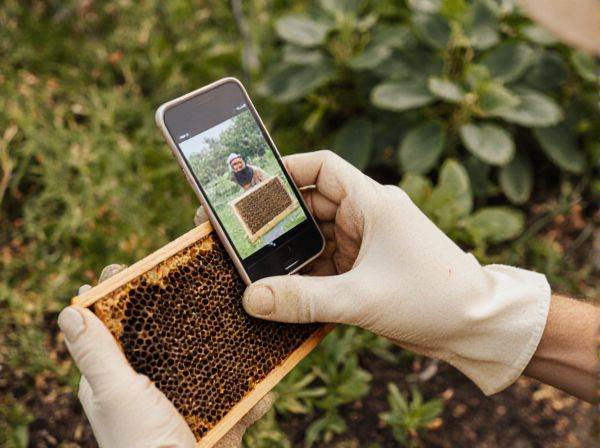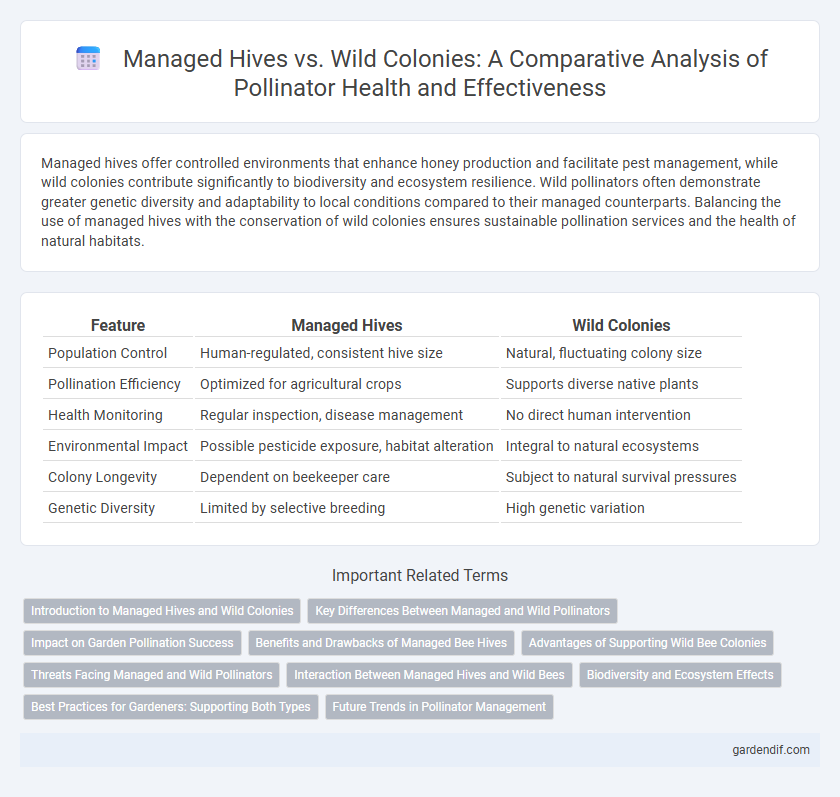
Managed Hives vs Wild Colonies Illustration
Managed hives offer controlled environments that enhance honey production and facilitate pest management, while wild colonies contribute significantly to biodiversity and ecosystem resilience. Wild pollinators often demonstrate greater genetic diversity and adaptability to local conditions compared to their managed counterparts. Balancing the use of managed hives with the conservation of wild colonies ensures sustainable pollination services and the health of natural habitats.
Table of Comparison
| Feature | Managed Hives | Wild Colonies |
|---|---|---|
| Population Control | Human-regulated, consistent hive size | Natural, fluctuating colony size |
| Pollination Efficiency | Optimized for agricultural crops | Supports diverse native plants |
| Health Monitoring | Regular inspection, disease management | No direct human intervention |
| Environmental Impact | Possible pesticide exposure, habitat alteration | Integral to natural ecosystems |
| Colony Longevity | Dependent on beekeeper care | Subject to natural survival pressures |
| Genetic Diversity | Limited by selective breeding | High genetic variation |
Introduction to Managed Hives and Wild Colonies
Managed hives are controlled environments maintained by beekeepers to optimize honey production and pollination services, featuring regular inspections, disease management, and strategic placement. Wild colonies thrive in natural habitats without human intervention, contributing to biodiversity and ecosystem resilience through natural foraging and reproductive behaviors. Both managed hives and wild colonies play critical roles in sustaining pollinator populations and supporting agricultural productivity.
Key Differences Between Managed and Wild Pollinators
Managed hives consist of domesticated bee colonies maintained by beekeepers for agriculture pollination, offering controlled environments and consistent honey production. Wild colonies thrive naturally without human interference, supporting greater genetic diversity and resilience in ecosystems. Key differences include population stability, genetic variation, and susceptibility to diseases, which impact pollination efficiency and ecosystem health.
Impact on Garden Pollination Success
Managed hives provide consistent and controllable pollination services, significantly boosting fruit and vegetable yields in gardens. Wild colonies contribute to biodiversity and support a wider range of plant species through diverse foraging behaviors, enhancing overall ecosystem resilience. Combining both sources maximizes pollination success by ensuring high pollinator density and maintaining ecological balance.
Benefits and Drawbacks of Managed Bee Hives
Managed bee hives offer controlled environments that enhance pollination efficiency and agricultural productivity through selective breeding and hive management techniques, boosting crop yields by up to 30%. However, they face risks such as disease transmission, pesticide exposure, and increased stress on bees compared to wild colonies, which tend to have greater genetic diversity and natural resilience. Balancing the benefits of predictable pollination services with the drawbacks of potential colony collapse remains crucial for sustainable apiculture practices.
Advantages of Supporting Wild Bee Colonies
Supporting wild bee colonies enhances biodiversity by preserving native pollinator species adapted to local ecosystems. Wild colonies contribute to pollination resilience, ensuring ecosystem stability amid environmental changes and disease pressures affecting managed hives. Moreover, wild bees often pollinate a broader range of plants, improving genetic diversity and crop yields in adjacent agricultural areas.
Threats Facing Managed and Wild Pollinators
Managed hives face threats such as pesticide exposure, parasite infestations like Varroa mites, and habitat loss due to agricultural intensification. Wild pollinators encounter similar risks, compounded by climate change, fragmentation of natural habitats, and competition from invasive species. Both managed and wild pollinators are vulnerable to diseases like Nosema and environmental stressors that reduce their population resilience.
Interaction Between Managed Hives and Wild Bees
Managed hives and wild bee colonies often interact through shared foraging resources, influencing both competition and pollination efficiency in ecosystems. The density of managed hives near wild habitats can lead to resource depletion, potentially stressing wild bee populations while also facilitating disease transmission between managed and wild bees. Understanding these interactions is critical for balancing agricultural pollination needs with the conservation of native bee biodiversity.
Biodiversity and Ecosystem Effects
Managed hives provide consistent pollination services but can reduce genetic diversity due to selective breeding and crowding, potentially impacting local wild pollinator populations. Wild colonies contribute to maintaining biodiversity by supporting diverse floral species through varied foraging patterns and genetic variability, thereby enhancing ecosystem resilience. Balancing managed hive practices with conservation of wild pollinators is crucial for sustaining ecosystem functions and overall biodiversity health.
Best Practices for Gardeners: Supporting Both Types
Gardeners can enhance pollination by providing diverse habitats that cater to both managed hives and wild colonies, such as planting native flowering species and avoiding pesticides. Installing bee hotels and preserving natural nesting sites supports wild pollinators, while maintaining healthy managed hives through regular inspections prevents disease spread. Combining these practices optimizes pollinator health, biodiversity, and crop yields in garden ecosystems.
Future Trends in Pollinator Management
Managed hives are increasingly integrated with precision technology and data analytics to optimize colony health and pollination efficiency, offering predictable outcomes for agricultural productivity. Wild colonies remain essential for maintaining biodiversity and ecosystem resilience, prompting conservation efforts to focus on habitat preservation and minimizing pesticide exposure. Future trends in pollinator management emphasize a hybrid approach combining artificial hive enhancement with natural habitat restoration to ensure sustainable pollination services amid climate change challenges.
Managed Hives vs Wild Colonies Infographic

 gardendif.com
gardendif.com